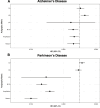Impaired 24-h activity patterns are associated with an increased risk of Alzheimer's disease, Parkinson's disease, and cognitive decline
- PMID: 38355598
- PMCID: PMC10865579
- DOI: 10.1186/s13195-024-01411-0
Impaired 24-h activity patterns are associated with an increased risk of Alzheimer's disease, Parkinson's disease, and cognitive decline
Abstract
Background: Sleep-wake regulating circuits are affected during prodromal stages in the pathological progression of both Alzheimer's disease (AD) and Parkinson's disease (PD), and this disturbance can be measured passively using wearable devices. Our objective was to determine whether accelerometer-based measures of 24-h activity are associated with subsequent development of AD, PD, and cognitive decline.
Methods: This study obtained UK Biobank data from 82,829 individuals with wrist-worn accelerometer data aged 40 to 79 years with a mean (± SD) follow-up of 6.8 (± 0.9) years. Outcomes were accelerometer-derived measures of 24-h activity (derived by cosinor, nonparametric, and functional principal component methods), incident AD and PD diagnosis (obtained through hospitalization or primary care records), and prospective longitudinal cognitive testing.
Results: One hundred eighty-seven individuals progressed to AD and 265 to PD. Interdaily stability (a measure of regularity, hazard ratio [HR] per SD increase 1.25, 95% confidence interval [CI] 1.05-1.48), diurnal amplitude (HR 0.79, CI 0.65-0.96), mesor (mean activity; HR 0.77, CI 0.59-0.998), and activity during most active 10 h (HR 0.75, CI 0.61-0.94), were associated with risk of AD. Diurnal amplitude (HR 0.28, CI 0.23-0.34), mesor (HR 0.13, CI 0.10-0.16), activity during least active 5 h (HR 0.24, CI 0.08-0.69), and activity during most active 10 h (HR 0.20, CI 0.16-0.25) were associated with risk of PD. Several measures were additionally predictive of longitudinal cognitive test performance.
Conclusions: In this community-based longitudinal study, accelerometer-derived metrics were associated with elevated risk of AD, PD, and accelerated cognitive decline. These findings suggest 24-h rhythm integrity, as measured by affordable, non-invasive wearable devices, may serve as a scalable early marker of neurodegenerative disease.
Keywords: Alzheimer’s disease; Cognitive aging; Parkinson’s disease; Rest-activity rhythms.
© 2024. The Author(s).
Conflict of interest statement
The authors declare that they have no competing interests.
Figures




Similar articles
-
Circadian disturbances in Alzheimer's disease progression: a prospective observational cohort study of community-based older adults.Lancet Healthy Longev. 2020 Dec;1(3):e96-e105. doi: 10.1016/s2666-7568(20)30015-5. Epub 2020 Nov 12. Lancet Healthy Longev. 2020. PMID: 34179863 Free PMC article.
-
Pharmacotherapies for sleep disturbances in dementia.Cochrane Database Syst Rev. 2016 Nov 16;11(11):CD009178. doi: 10.1002/14651858.CD009178.pub3. Cochrane Database Syst Rev. 2016. Update in: Cochrane Database Syst Rev. 2020 Nov 15;11:CD009178. doi: 10.1002/14651858.CD009178.pub4. PMID: 27851868 Free PMC article. Updated.
-
One-year practice effects predict long-term cognitive outcomes in Parkinson's disease.J Parkinsons Dis. 2025 Jun;15(4):858-867. doi: 10.1177/1877718X251339585. Epub 2025 Apr 29. J Parkinsons Dis. 2025. PMID: 40302413
-
Withdrawal or continuation of cholinesterase inhibitors or memantine or both, in people with dementia.Cochrane Database Syst Rev. 2021 Feb 3;2(2):CD009081. doi: 10.1002/14651858.CD009081.pub2. Cochrane Database Syst Rev. 2021. PMID: 35608903 Free PMC article.
-
Selegiline for Alzheimer's disease.Cochrane Database Syst Rev. 2003;(1):CD000442. doi: 10.1002/14651858.CD000442. Cochrane Database Syst Rev. 2003. PMID: 12535396
Cited by
-
Multidimensional Sleep Profiles via Machine learning and Risk of Dementia and Cardiovascular Disease.medRxiv [Preprint]. 2024 Aug 20:2024.08.19.24312248. doi: 10.1101/2024.08.19.24312248. medRxiv. 2024. Update in: Commun Med (Lond). 2025 Jul 22;5(1):306. doi: 10.1038/s43856-025-01019-x. PMID: 39228701 Free PMC article. Updated. Preprint.
-
Wearables in Chronomedicine and Interpretation of Circadian Health.Diagnostics (Basel). 2025 Jan 30;15(3):327. doi: 10.3390/diagnostics15030327. Diagnostics (Basel). 2025. PMID: 39941257 Free PMC article. Review.
-
Multi-modal machine learning approach for early detection of neurodegenerative diseases leveraging brain MRI and wearable sensor data.PLOS Digit Health. 2025 Apr 25;4(4):e0000795. doi: 10.1371/journal.pdig.0000795. eCollection 2025 Apr. PLOS Digit Health. 2025. PMID: 40279355 Free PMC article.
-
Multidimensional sleep profiles via machine learning and risk of dementia and cardiovascular disease.Commun Med (Lond). 2025 Jul 22;5(1):306. doi: 10.1038/s43856-025-01019-x. Commun Med (Lond). 2025. PMID: 40696147 Free PMC article.
-
Detecting Sleep/Wake Rhythm Disruption Related to Cognition in Older Adults With and Without Mild Cognitive Impairment Using the myRhythmWatch Platform: Feasibility and Correlation Study.JMIR Aging. 2025 Apr 7;8:e67294. doi: 10.2196/67294. JMIR Aging. 2025. PMID: 40194310 Free PMC article.
References
Publication types
MeSH terms
Grants and funding
LinkOut - more resources
Full Text Sources
Medical

